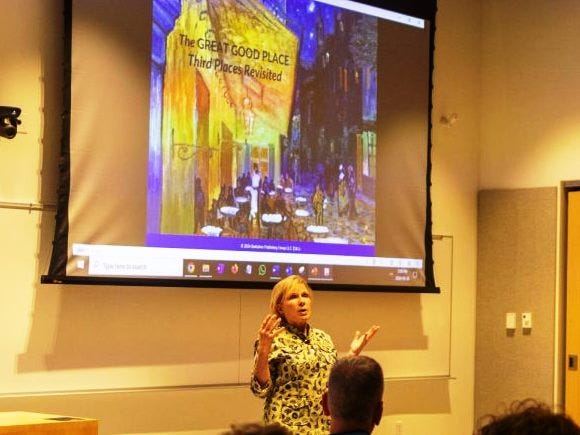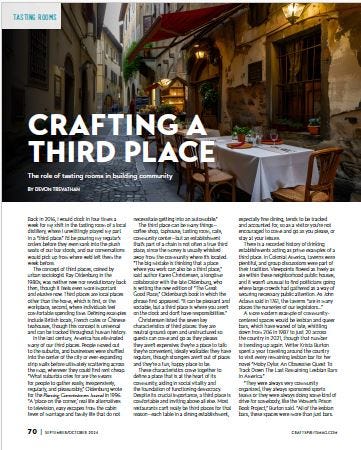Last Thursday I spoke about third places at UMass, Amherst and since then there has been a flood of new press and new ideas coming my way - all grist to the mill, as I am about to start sending sections of the new book manuscript to my favorite copyeditor. (Here’s the article that appeared in the Massachusetts Daily Collegian: Karen Christensen explores the concept of ‘third places.’ It was a treat to talk to students, as well as to the faculty.) And I have a question for you, about talking to people on trains and other public transportation.
On Tuesday I was drafted at the last minute to talk to an OLLI class on climate change by my friend Deborah Caine, who said I could use my UMass presentation. This meant a quick pivot to focus on how designing for third places is also designing for climate resilience. While I wasn’t ready to lay this out in full, it was good to have a chance to talk through some of the ways these two design challenges coincide.
One class member student mentioned the German term Stammtisch - a group that meets regularly, and its regular table. It’s an ideal addition to the third places story and to the shape of third places. The tables are round, a feature that is important in Chinese culture and that was part of the early design of Starbucks coffee shops. Here’s what Ray Oldenburg wrote:
In this as in the German culture, the habitues of many public places claim their own table, which is “permanently reserved” but not usually marked as such. The loyal regular is a Stammgast, and both the table and the group of cronies who daily congregate at it are known as Stammtisch. Unlike the English coffeehouse, in which anyone could approach anyone else, individual or group, and be accepted, the Viennese coffeehouse is constituted of small private worlds. The members of a Stammtisch make no bones about letting outsiders know they are not welcome to join the group. Though Herr Ober’s actions in directing the customer to a given location may seem dictatorial and capricious, he is often doing no more than protecting the territory of the regulars.
There was also a comment about how in Europe when you take a train people aren’t all staring at their devices - they talk to one another and even talk to strangers.
This came to mind when I got an email from a journalist who wants to talk about trains and public transit as third places. Café and dining cars should be part of the train experience, but this is another area in which US trains fall short. I still regret not having dared to try something from the cart being rolled up and down the first Chinese train I took, from Guangzhou to Hong Kong in 2006. This wasn’t just tea and biscuits and sandwiches, which you can buy from carts on UK trains, but hot fragrant chicken pieces and other things I wasn’t sure I could manage neatly. What a failure on my part!
As I reflect on this, I’ve realized that people have often started conversations with me and it’s generally been a pleasure. (In fact, I married someone I met on a bus at UCSB.) Do you talk to people on trains, or subways or buses? Have you ever had regular acquaintances on a commuter train, or made a friend on a longer trip?
Watering holes
Many people are looking for ways to create third places or enhance the social aspect of their businesses. I’ve just received a link to an issue of Craft Spirits Magazine with an article about third places that quotes Ray and me. The article is on page 70.
And the conversation about Starbucks has continued. A Substack writer contacted me to ask about third places and Starbucks, and wrote a detailed newsletter on the subject, which you can read here. He also led me to Everything but the Coffee, a book about Starbucks that I’m chagrined to have missed because it has an entire chapter about the third places aspect of that company’s history. Bryant Simon is a professor at Temple University and wrote a thorough overview of third places and even went to Florida and interviewed Ray about his experience with Starbucks executives (I’m not sure if he met Howard Schultz).
I’ve been asked if there are events or conferences where third places - and all the related issues - are discussed. Since there is no venue for interdisciplinary discussion of topics like this, something I realized when working on the Encyclopedia of Community, I am thinking of organizing a small online forum, by invitation, for people with special interest and expertise - including urban planning, rural studies, sociology, psychology, and more. I’d like to bring practitioners and businesspeople into the mix, too. Please stay tuned.








I have often noticed, commented on, and enjoyed the fact that people on the street, including cops, talk to each other ALL THE TIME. I live in midtown Manhattan most days I have a conversation or two with complete strangers. When you walk by a cop, s/he says "how are you today?" This isn't true everywhere, especially with law enforcement. But I just love that New Yorkers are reflexively social and interactive. It's a big deal.
I have found my local grocery store to be a "Third Place"...A Great Good place. They know us at the pharmacy before we have to say our name. We see friends there and people who have become friends....baggers, checkers, managers. There is always some conversation. Sometimes a hug. I've been shopping there for many years. It's not a big-box store or "club". It's a chain, but has preserved its mission of inclusion and diversity. not too big and not too small...just right! Goldilocks would have loved it!